Of all Italian cities, Milan probably deems the least what we consider Italian. No jolly groups sipping Aperol Spritz while playing boccia. Instead, executives rush from their stately apartment houses to offices in glittering business centers. Hardly a narrow cobblestone alley. Rather big cars on broad avenues. Money makes the world Milan go round.
And yet, if you visit with an open mind, Milan will by no means disappoint: Get the big picture from the roof of the Duomo, and enjoy contemporary art at various industrial sites that were transformed into humongous art galleries. Window shop at the posh Brera district or the fabulous Galleria Vittorio Emanuele II. Admire Leonardo da Vinci’s Cenacolo, hence, the Last Supper. Oh, talking ’bout food: Finish a long day of sightseeing with a relaxed Milanese Aperitivo in one of the countless bars alongside the Navigli, the city’s old waterways.
Sounds like a plan? Mind you, these are only a few of the best things you should do in Milan on a long weekend!

No Better Way to Start the Day
As I said, Milan has no Vesuvius, no David, and no Colosseum. It has no singing gondoliers and no narrow streets in which a large family’s laundry hangs to dry on lines stretched between windows. Yet, even if the highly developed city center is deemed almost German to some visitors, at least architecturally, Milan is undeniably a very Italian city. However, the traditional side of Italy is more likely to be found in the non-touristy residential areas.
If you are in search of Milan’s Italian side, there’s no better way to start the day than with breakfast in one of the countless bars. Even though for most Italians the first meal of the day is the least important one, the ritual of a quick breakfast at the counter of one of the countless bars is simply as Italian as can be.
It’s like they say: When in Rome Milan…

While there are all those fancy places with their state-of-the-art coffee machines, their tasteful decoration, and elegant flower arrangements where you pay a small fortune for an even smaller sandwich, the real thing does not happen in the historic center or the financial district.
In da Hood
However, the real early morning dolce vita takes place in the many charmless, projectlike neighborhoods where the bar is not some hip rooftop joint but a small café nestled between a butcher’s shop and a tabacchi, a typical Italian kiosk. It’s here where with your coffee and a far too sweet cornetto, the Italian version of a croissant, you’ll rub shoulders with the average Italian. Every morning.
It’s people-watching at its best.
Ciao Giorgio! Buongiorno Sara! Come stai, Marco?
The lady behind the counters knows them all by name and their family story by heart. Most of the younger folks just rush in, grab a coffee, jokingly exchange some pleasantries, and off they go to do their daily chores.
But some can make time to linger a little. The tattooed ragazze in far too tight low-cut jeans, their faces caked in layers of make-up don’t acknowledge either the coffee they’re drinking or each other while scrolling through their phones. The old lady leaning on her cane, sipping some bitter black brew from a tiny cup. Next to her, an indulgent grandfather gives the whining grandson in the cart a sugar cube.
Dog Days
Now a thin young man enters the coffee shop. No, he doesn’t enter, he’s dragged in by a dog who probably weighs about the same as his owner. And no matter how hard the young man tries to prove who’s boss, it’s clearly the dog. The dog sniffs ferociously and rushes from table to table, frantically licking a few crumbs from the floor here and nudging a guest there. The skinny man tries to prevent the worst, straightens chairs, keeps screaming Cannella, Cannella. It’s Cannella!, an elderly lady cries out in excitement: I knew you when you were sooo little!
I’m pretty sure she’s talking to the dog and not its owner. However, when I look at the spectacle around me, I’m quite sure that some people here already knew each other when they were sooo little. On one wall, there is a collage of passport photo-sized portraits of people. All of them could be the cast of a Fellini movie. An incredible collection of characters. The collection covers almost the entire wall and above is written The regulars of 2023.
For a brief moment, I feel a little jealous. It must be nice to be part of such a close-knit community. I am just an onlooker who is granted a quick glance into real life in Italy.
Historic Center
After this holistic Italian experience, it’s an almost shockingly short journey of just four metro stops to the relentless tourist hype that takes place in the Piazza del Duomo.
As a precursor to today’s square, a kind of market square, the so-called Piazza dell’Arengo, was built already back in 1330. In 1458, with the approval of Pope Pius II, Francesco Sforzas had the Basilica di Santa Tecla demolished to create a large, dignified cathedral court. The square has been repeatedly changed and expanded over the centuries. However, it only acquired its current appearance at the end of the 19th century, when the plans of the architect Giuseppe Mengoni were implemented.
The square is of course dominated by the Milan Cathedral, in front of which visitors from all over the world get tangled up with their cell phone sticks and try to get a picture not only of the oversized building, but above all of themselves.

For me personally, Duomo Square is one of the most annoying places in all of Milan. It’s always loud, you have to be on your guard all the time, it’s terrible. Nevertheless, there is no way around it, because the piazza marks the center of the city, not only because of its artistic and cultural importance, but also in a geographical sense. The rectangular 17,000 square meters large piazza is lined with some of Milan’s most important historic buildings.
Duomo di Milano
The Metropolitan Cathedral of the Nativity of the Blessed Virgin Mary, aka the Duomo, is one of the largest churches in the world. Construction began in 1386, yet, it was still not finished by the time it was finally consecrated almost 200 years later. Then, construction continued to be rather bumpy. In fact, it took almost six centuries to complete this Gothic masterpiece!
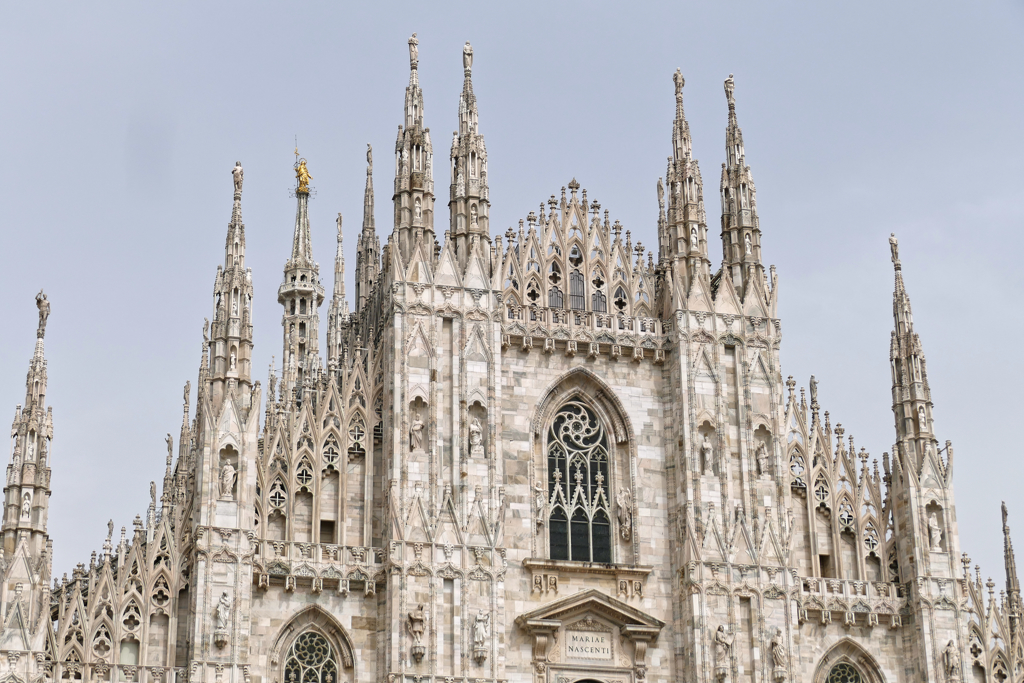
Today, the Duomo with its intricate façade boasts an impressive 3,400 towers and statues. Also, one entrance is not enough. Therefore, there are five portals leading inside. The most beautiful one is, of course, the central portal with bronze doors showing the seven delights of Mariae in comparison to her seven sorrows.

With its columns and stained glass windows, the cathedral is also impressively beautiful inside, obviously.

I’d argue that to visitors, the cathedral’s most alluring feature is the roof that can be walked upon. Up there, you can take a close look at the lavishly constructed stonemasonry and the golden statue of Madonnina, the city’s protector. Obviously, you also have an unobstructed view of the entire city and beyond; on clear days all the way to the Alps!

In short: Whether you’re a history buff, an architecture lover, or simply someone looking for a breathtaking view, a visit to the Duomo di Milano is a must!

Once you’re back on the ground, don’t forget to pay the Duomo Museum a visit for a close look at the sacral treasures. It’s located across the street inside the former Royal Palace.
Plan Your Visit
Visiting the Duomo di Milano should be a memorable experience, hence, here’s some practical information to help you plan your visit.

Does the archangel Michael hold an umbrella in his right hand as he’s expelling Adam and Eve?
Anyway, this is only one of the uncountable alluring bas-reliefs covering the Duomo’s façade.
The Cathedral is open every day from 8 a.m. to 7 p.m. as long as there is no service taking place. The roof terrace opens only at 9 a.m. and closes at 7 p.m., however, the last admission is already at 6.10 p.m. The museum and San Gottardo Church is open from Thursday to Tuesday between 10 a.m. and 6 p.m.
There are various ticket options and different combo tickets available. When planning your visit, you should definitely check out their website for the version that suits you best and preferably also purchase your ticket right away online to avoid standing for hours in long queues.
Galleria Vittorio Emanuele II
Of course, no other building can match the splendor of the Duomo so easily. Nevertheless, the Galleria Vittorio Emanuele II, which borders the Piazza del Duomo to the north, has been at least just as popular as a Milan motif as the famous sacred building – at least since the existence of Instagram.
From the square, you enter the oldest covered shopping arcade in the world appropriately through a triumphal arch. If you cross straight over to the opposite northern side of the complex, you get to the Piazza della Scala in front of the world-famous opera house.
In 1865, in celebration of the unification of Italy, King Vittorio Emanuele II laid the foundation stone for the Galleria named after him, which was then built within three years. Probably hardly any of those who are pressing their noses against the shop windows of Armani, Gucci, Prada, and Versage realize that this structure was a momentous signifier of national identity. After all, an Italian state was only proclaimed in 1859.

Designed by architect Giuseppe Mengoni, the complex consists of two intersecting wings spanned by a barrel-shaped glass roof. Everything is lavishly decorated with stucco, frescoes, and marble. Where the wings intersect, a 47-meter-high glass dome covers an octagonal center court. Mosaics of the coats of arms of Rome, Florence, Turin, and Milan are embellishing the court’s floor.
Piazza Mercanti
In the middle of densely built-up Milan in the Middle Ages, before the Milan Cathedral was even thought of, the Piazza dei Mercanti emerged in the 13th century as a central craft and trading center. Today, it is just a few steps west of the Piazza del Duomo.

In the rectangular square, which was even larger in the past, barbers, tailors, goldsmiths, cobblers, bakers, and many other traders and craftsmen plied their trade.

In 1228, work began on the Palace of Justice, which is still located in the center of the Piazza Mercanti. To this day, an equestrian bas-relief honors the mayor of Milan, Oldrado da Tresseno, who commissioned the construction.
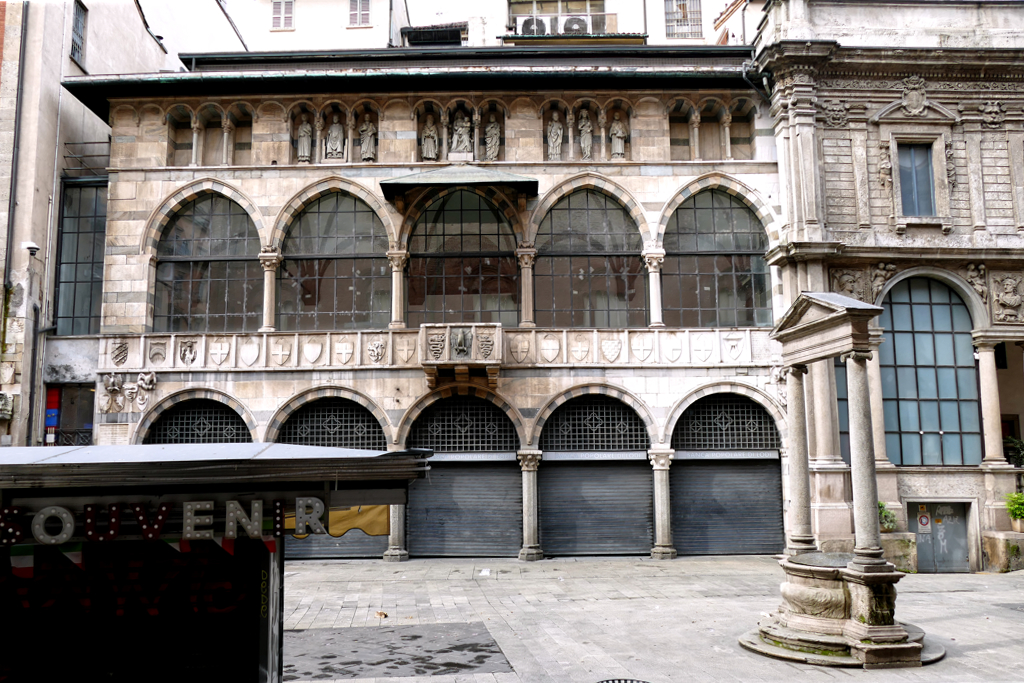
Another impressive building is the Loggia degli Osii opposite the Palazzo delle Ragione. It was built in 1316 under Matteo Visconti to provide a seat for court notaries. Unusually for the Lombard architectural style, the Gothic façade was designed using strips of marble, as is often found in Liguria. Public announcements were made from the balcony. It is decorated with the coat of arms of the House of Visconti, and above the upper floor is a row of sculptures of the city’s saints.
Fun fact:
If a merchant in the Piazza Mercanti betrayed and thusly fell into disgrace, he was exposed to public ridicule as punishment. To do this, he had to sit on the so-called Stone of the Failed with his pants down. There, he was mocked by the common people before he had to go to prison.
Old Masters: Leonardo, Michelangelo, Andrea Montegna
Among all the Italian cities popular for their world-famous cultural treasures, Milan is undisputedly pretty much at the end of the list. Although it is the country’s second-largest city after Rome, there are fewer landmarks than in some far more provincial towns. So if you come to Milan for Baroque or Renaissance masterpieces, you’ll get through with your itinerary quite quickly. However, you won’t be disappointed, because, among Milan’s art museums, there are some treasure chests packed with outstanding masterpieces that are among the most famous in the art diaspora.

As I said, the number of art treasures is manageable, hence, you don’t need to sacrifice entire days for museum visits, nevertheless, it would be a shame to miss out on those gems.
Pinacoteca Ambrosiana
Only two blocks southwest of the Piazza Mercanti is the famous Biblioteca Ambrosiana with its amazing Pinacoteca and the Cripta San Sepolcro.
I made quite condescending comments about the venue and the collection in the previous version of this post. For some reason, I remember the galleries being a pointless hodgepodge of second-rate paintings. Either I was simply oversaturated at the time of my visit or they have improved tremendously in recent years. In any case, I was quite enthusiastic about the visit this time.

Although there is an impressive collection of paintings and sculptures on display, the most important work is undoubtedly the Basket of Fruit by Michelangelo Merisi aka Caravaggio. Many art historians see his fruit basket from around 1599 as one of the earliest if not the first Italian still life. Moreover, it is the artist’s only surviving autonomous still life and the smallest picture he has ever painted.

There’s More
Adjacent to the Pinacoteca is the Biblioteca Ambrosiana, one of the oldest libraries in Europe that holds a vast collection of ancient manuscripts and books. Next to the complex is the Church of San Sepolcro from 1030. In 1928, the church was annexed to the Biblioteca Ambrosiana, which administers it to this day. The crypt below the church is also open for touristy visits, however, you need an extra ticket.

The Pinacoteca Ambrosiana can be visited from Monday to Sunday between 10 a.m. and 6 p.m. for a general admission of 15 €uro. The Crypt, however, is open from Thursday to Tuesday for a general fee of 8 €uro. A combined ticket costs only 20 €uros, however, make sure to check out their various packages on their website when planning your visit. Also, since the Pinacoteca Ambrosiana is one of Milan’s most popular museums, booking your tickets in advance is highly recommended.
Pinacoteca di Brera
Brera is a popular bohemian and artistic district that is often compared to Montmartre in Paris. Apart from the famous academy and the gallery, the district is home to countless art and antique shops, posh fashion stores, colorful street markets, restaurants, cafés, and bars.

The Pinacoteca di Brera is housed in the baroque Palazzo di Brera which is one of the most influential art museums in Italy. The painting collection goes back to the founding of an art academy in 1776 when Lombardy belonged to the Habsburg Empire.

How It All Began
The basis for the collection was altarpieces that came into the collection after Napoleon dissolved monasteries and churches. He had the most valuable works taken to the Louvre in Paris, obviously.

The despised works then formed the basis of Italian art collections in Bologna, Venice, and Milan. The focus of the collection is therefore on Italian paintings of the Renaissance and Baroque periods. But younger art eras are also represented alongside early antiquity and Dutch baroque painting.

In 1882 the academy and museum were divided into two independent institutions. This had fatal consequences for the collection, as it was subsequently distributed to other museums.

However, when you’re finished with the visit to the galleries, be sure to take a look at the impressive library Biblioteca Braidense before ending your visit with a coffee and a snack in the sophisticated Caffè Fernanda.

The Pinacoteca di Brera can be visited from Tuesday to Sunday between 8.30 a.m. and 7.15 p.m. for a general admission of 15 €uro.

Cenacolo Vinciano
Milan has exactly one UNESCO World Heritage Site and that is the Last Supper by Leonardo da Vinci. It adorns the wall of the former refectory of the church Santa Maria delle Grazie in the Magenta District. It’s just under half an hour’s walk from Brera to Magenta, but if you don’t feel like walking you can of course hop on a tram.

However, don’t think that you can just waltz into the refectory whenever you please. You must book your ticket well in advance, and you need to specify an exact visit time.
Then, supplied with your personal booking number, you need to show up around thirty minutes ahead to pick up your ticket. Eventually, you’re waiting on a wooden bench with a dozen people who booked the same time slot as you.

Due to the tight time slots, often at least two groups are waiting at the same time, feeling competition, eyeballing each other suspiciously.
At the designated time, a guide – or should I say guard? – shouts a number and everybody is pushing towards a sliding glass door. It’s like a frigging high-security wing. One door has to close behind the group before the next opens. This goes on and an: Slide, slide, repeat. Finally, you are standing in the refectory.
From this moment on, you have fifteen minutes to marvel at the fresco.

There’s not a lot to marvel at in one single fresco. Even if you take a couple of pictures and turn to the painting on the opposite wall.
But the ticket is 15 €uro, hence you marvel till you can marvel no more to get your money’s worth. Plus, they won’t let you out any earlier, anyway.
After 13 minutes the guard finally releases you from by now mindless staring, announcing that in two minutes, the next marvellers will get in.
Again, on your way out you have to pass some security door systems as if you’re escaping a quarantine laboratory.
Plan Your Visit
Although the procedure is kinda crazy, the Cenacolo is a must when visiting Milan! It can be seen Tuesday to Sunday between 8.15 a.m. and 6. 45 p.m. Tickets should be purchased as early as possible either online through the official website of the Cenacolo Vinciano Museum or the call center at + 39 02 92 80 03 60. Especially during the high season, tickets sell out quickly. However, guided tours by companies like GetYourGuide* often include a visit to The Last Supper. This way, you get to see it even if they are sold out on the official site.
Note that children under the age of 18 can visit for free, yet, they still need a reservation!
Make sure to arrive at least 15 minutes before your scheduled time. If you’re late, you probably won’t be admitted.
Also, admission is free on the first Sunday of each month. However, these tickets need to be booked online starting from the preceding Wednesday at noon and tend to sell out right away, obviously.
Castello Sforzesco and its Museums
Pietà Rondanini
Apart from the world-famous Cenacolo by da Vinci and the masterpieces by Caravaggio, Milan has another extraordinary work of art displayed in a side wing of the Palazzo Sforzesco.
As a matter of fact, you can visit the fortress’ grounds and external structures free of charge. Only if you want to see the inside, you need an entry ticket. However, it’s worth it, especially because entry to the Municipal Museums in Milan is quite cheap. For only 8 €uros, you can visit the entire castle including all the galleries on the premises.
Hence, included in the admission ticket is also Michelangelo’s last, unfinished masterpiece, the Pietà Rondanini.
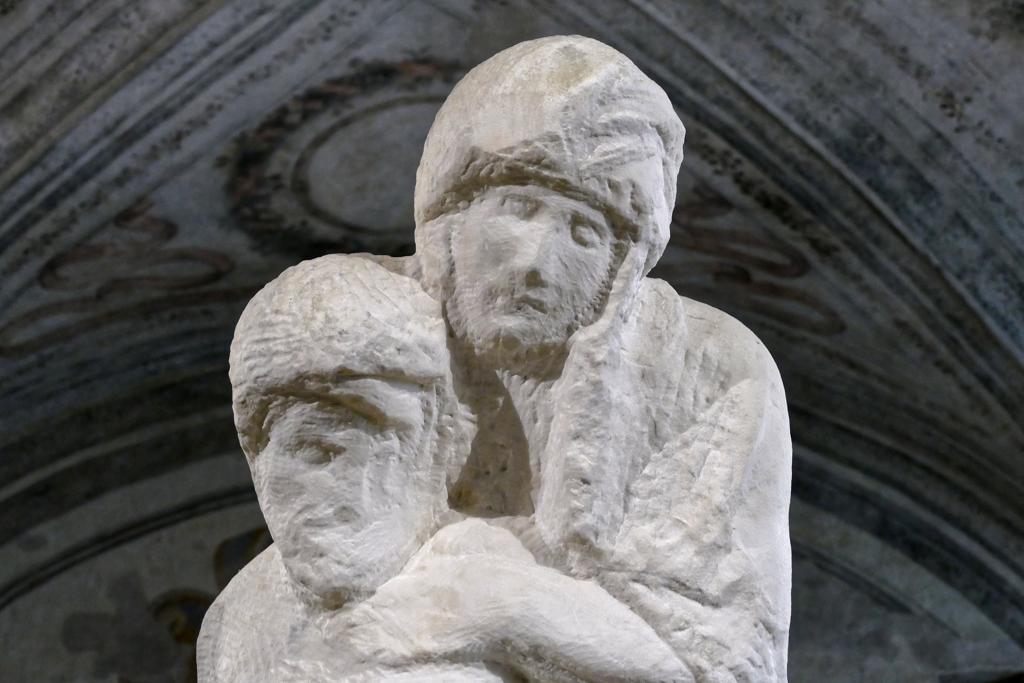
The Pietà Rondanini depicts the Virgin Mary holding the body of Jesus Christ after his crucifixion and represents a poignant expression of Michelangelo’s artistic vision in the later stages of his life. It differs significantly from his earlier works such as the Pietà in St. Peter’s Basilica in Rome.

In contrast to the polished surface, the Pietà Rondanini is rough and unfinished. However, this evokes an emotional quality of even deeper sadness.

Michelangelo worked intermittently on the Pietà Rondanini from around 1552 until his death in 1564. The unfinished state of the Rondanini Pietà is interpreted as a metaphor for the artist’s feeling of incompleteness.
Visitors can see the Pietà Rondanini in a quiet exhibition room, the ancient Spanish Hospital in the castle’s Cortile delle Armi, in a side wing of the Sforzesco Castle.
There’s More
Obviously, the Cortile delle Armi that houses the Pietà is just a tiny part of the Castello Sforzesco. The Visconti family commissioned the fortress in the 14th century. In the 15th century, it underwent significant transformations under Duke Francesco Sforza who had married Bianca Maria Visconti in 1441.

The castle is an outstanding example of Renaissance architecture, featuring a large central courtyard, robust defensive walls, and imposing towers. It combined functionality with luxurious residential quarters.

Today, the Castello Sforzesco is a popular destination for locals and tourists alike, especially because of the adjacent Parco Sempione. This green area offers plenty of space for walks and picnics and if you’re lucky, there will be a free sports or music event taking place during your visit.
Plan Your Visit
Visiting the castle complex itself is free. You only have to buy an entrance ticket if you want to visit one of the museums housed there. Particularly worth seeing are the Museum of Ancient Art, the Museum of Musical Instruments, and the Egyptian Museum. My favorite venue is of course the Pinacoteca, the picture gallery.

The premises can be accessed every day between 7 a.m. and 7.30 p.m. The galleries are open from Tuesday to Sunday between 9 a.m. and 5.30 p.m., and a general ticket that grants access to all of them sets you back only 8 €uros.

However, be aware that there is a Tourist Museum Card including all the so-called Musei Civici di Milano, hence, the Municipal Museums of Milan. For as little as 12 €uros, you have three days to visit not only the castle, but among others also the Museo del Novecento, Galleria d’Arte Moderna, the Museo del Risorgimento at the Palazzo Moriggia, the Museo Costume Moda at the Palazzo Morando, and the Casa Museo Boschi Di Stefano.
Italian Modern Art: Romanticism, Divisionism, Futurism
For more art worth seeing, you have to jump forward in time around 600 years. Not only do you get to see great art at the galleries I’m introducing below. Incomprehensibly, these venues are not among the highlights that every tourist wants to explore. That’s why you can take in the beautiful works and inviting rooms in peace and quiet, far away from the crowds.
Galleria D’Arte Moderna di Milano GAM
A visitor commented in the guest book of the Galleria D’Arte Moderna: “Arte Moderna – certainly not Toulouse-Lautrec and Renoir”. While he might have nailed that one, he still had the chance to see international artists such as Van Gogh, Cézanne, and Picasso among the many outstanding works of Italian Symbolism, Romanticism, and Divisionism.
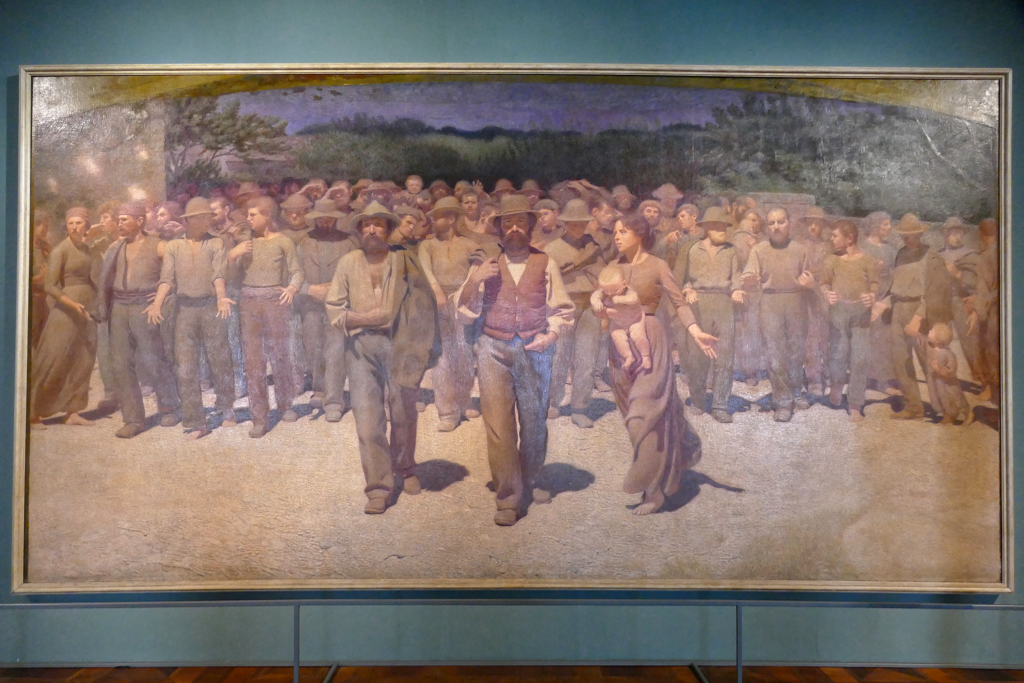
In 1903, it was decided to exhibit in one place all the works of modern art that the city of Milan had on loan or as property.

The Italian state donated the former Villa Belgiojoso Bonaparte to the city in 1920. It is a city palace completed in 1796 by the architect Leopoldo Pollack on behalf of Count Ludovico di Barbiano e Belgiojoso.

The palace is not only a prime example of Milan’s classicist architecture. The building also proved to be ideal as an art museum, so the Galleria d’Arte Moderna was opened the following year. Ever since Milan has celebrated the era of modern art with paintings and sculptures displayed in beautifully decorated rooms.

The most important of the 19th-century works are certainly of Italian origin. However, on the top floor is the superb Vismara collection. Giuseppe Vismara’s widow donated her late husband’s small yet exquisite collection of around forty works to the Municipality of Milan in 1975. It includes works of Italian and French Impressionism, Fauvism, and Cubism by Édouard Manet, Paul Cézanne, Paul Gauguin, Vincent van Gogh, Pablo Picasso, and Francesco Filippini. And believe it or not, that discontent visitor could very well have spotted a painting by Auguste Renoir in this section – albeit a largely unknown one.
Plan Your Visit
While the actual front of the city palace faces an English-style park, you enter the exhibition rooms through the entrance to the Via Palestro. The galleries are open from Tuesday to Sunday between 10 a.m. and 4.30 p.m. and the general admission is only 5 €uros.
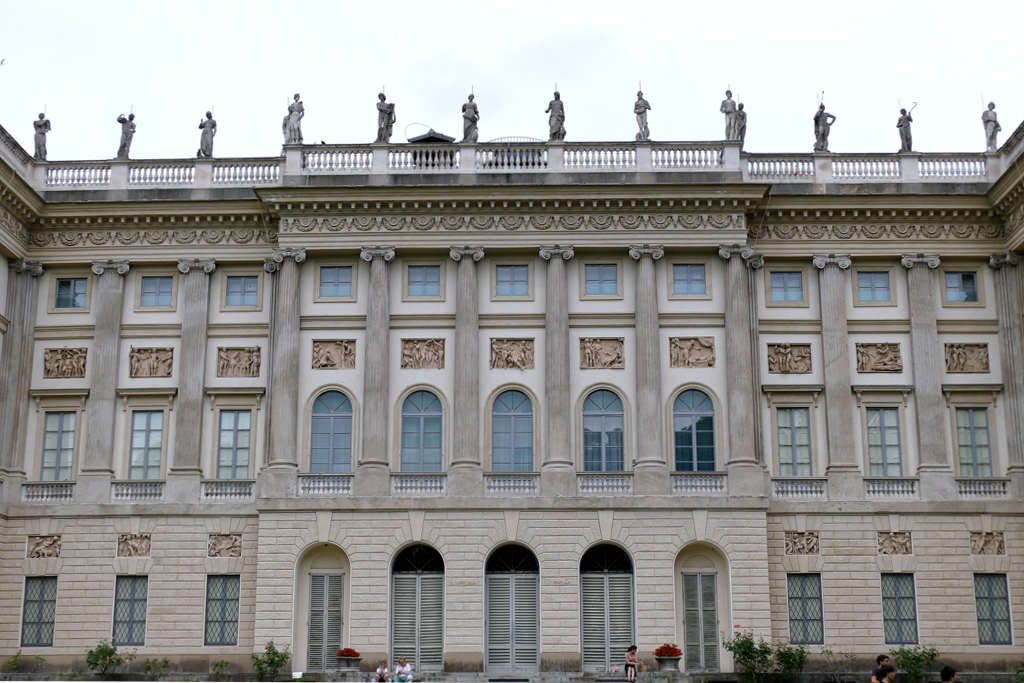
Across the inner courtyard in the entrance area is another gallery worth seeing, namely the Padiglione d’Arte Contemporanea, in short PAC.
This small art venue does not display a permanent collection, but rather organizes temporary exhibitions. Over the years I have only seen extraordinary shows there. Interestingly, art from countries that are not as much the focus of the art world such as Cameroon, Congo, and Cuba. So don’t forget to check what’s on while you’re in Milan.
The PAC is open Tuesday to Sunday from 10 a.m. to 7.30 p.m., on Thursdays even until 10.30 p.m. The general entrance fee is 8 €uro.
Museo del Novecento
Chronologically, after the epochs represented at the Galleria D’Arte Moderna, now comes the Novecento. It’s amazing how few visitors find their way to this gallery, given that it’s right next to the Duomo. I personally love the Novecento for its art, but also for the architecture and the amazing views from the 4th and 5th floors.
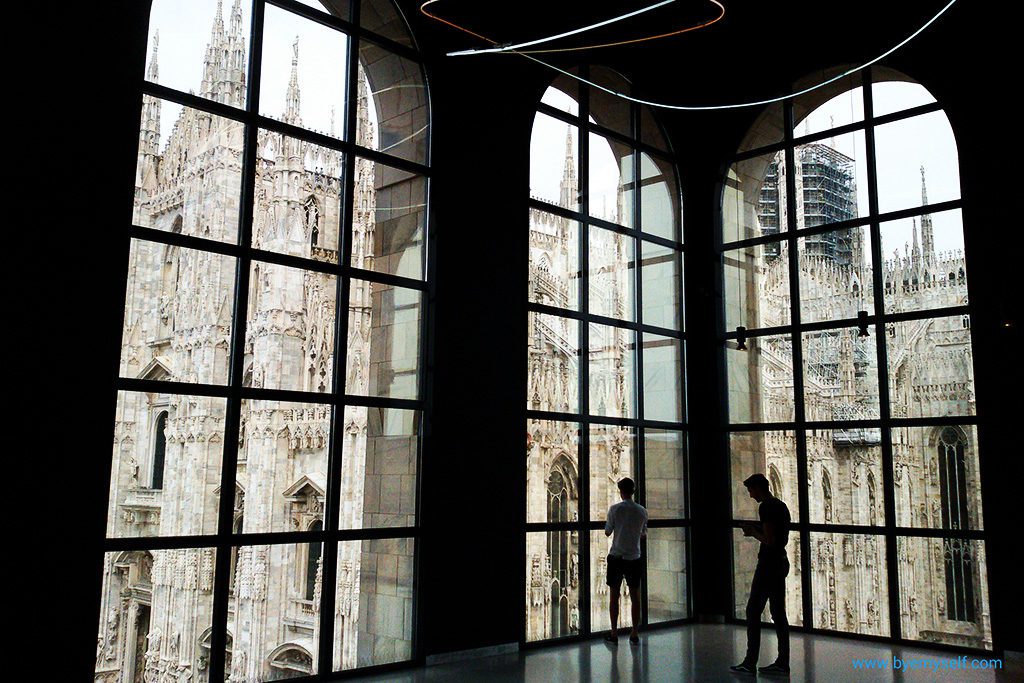
As I’m explaining below, Novecento in Italy means 900, but refers to the 20th century. The galleries opened in 2009 and took over the collections of the former Civico Museo d’Arte Contemporanea. In 2010, the façade was only conservatively restored, while the interior of the building was completely changed.

The Museo del Novecento extends over three floors of the Palazzo dell’Arengario and two rooms on the second floor of the Palazzo Reale. A spiral ramp takes you to the first floor, where the exhibition tour through the Italian avant-garde and futurism begins. On the second floor, the Novecento, Metaphysics, Rationalism, and Abstractionism are presented, and on the third floor are Informal Art, Spazialismo, and the Azimut artists. Over an open corridor, you get to the Palazzo Reale where, among others, kinetic art, Italian pop art, and Arte Povera are shown.
For a general entrance fee of 9.50 €uros, you can visit the galleries from Friday to Wednesday between 11 a.m. and 8 p.m.
Fun Fact:
Actually, it’s not a fun fact but a really relevant note: In most countries, the centuries are referred to retroactively. So when we talk about the 19th century, we mean the years from 1800 to 1899, the 20th century therefore includes 1900 to 1999.
This is different in Italy: The so-called Ottocento, hence 800, defines the years from 1800 to 1899. Therefore shows the Novecento, which translates to 900, the art period from 1900 – hence, what everyone else would call modern art from the 20th century.
From Business to Beauty: Contemporary Art Spaces
As I have emphasized many times, Milan represents dynamic, modern Italy. The Italy of the fashion industry and economy. There are also some remnants from the time when lackluster production sites provided income for the city. But industrial charm is the new black, and these manufacturing locations have become stylish and spacious exhibition spaces. Obviously, industrial facilities were not built in the heart of the city. Therefore, today’s galleries are a bit on the outskirts. However, they can be reached quickly and easily thanks to Milan’s good transport network.
Although I would argue that the exhibition spaces I present here reflect the spirit of modern-day Milan and are must-sees for several reasons, you are more likely to meet locals here than visitors from out of town. They still seem to be more of hidden gems.
Fondazione Prada
Miuccia Prada and Patrizio Bertelli established the Fondazione Prada as an institution, dedicated to contemporary art and culture. Founded in 1993 by the luxury fashion house, it has become a significant player in the global art scene. Today, there are venues in two Northern Italian cities, Milan and Venice. The Milan branch used to be a gin distillery from the early 20th century.
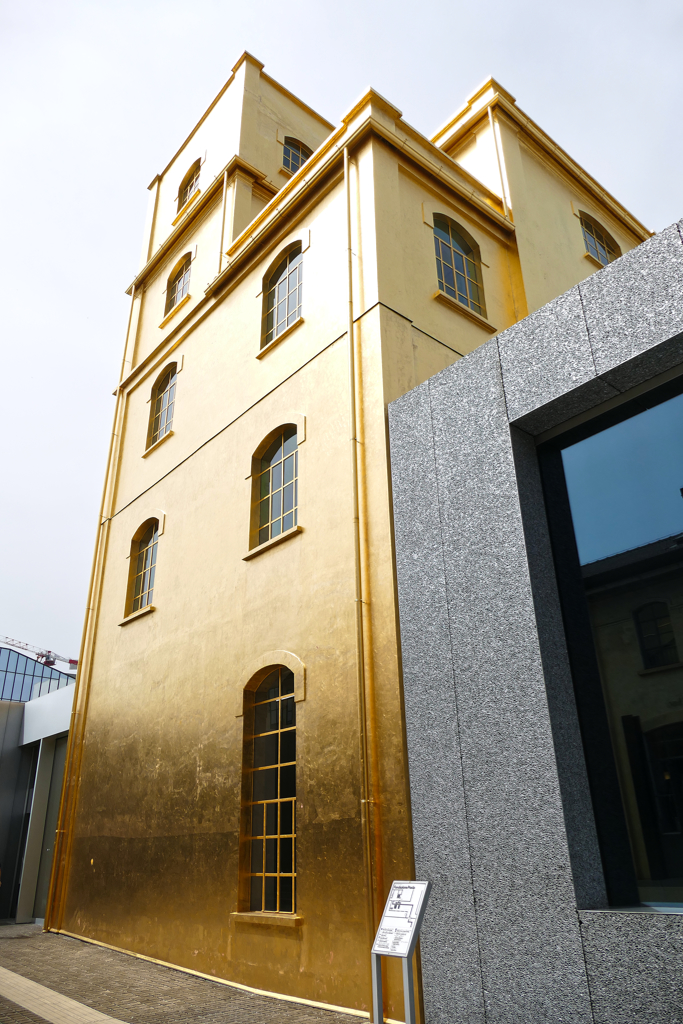
The venue opened in 2015 after Dutch architect Rem Koolhaas transformed the industrial building by juxtaposing old and new, combining industrial facilities with modern structures, creating a dynamic and versatile environment for all kinds of exhibitions and events.
Today, the Fondazione Prada stands for innovative exhibitions by both established and emerging artists. It doesn’t only presents visual art, but also organizes lectures, film screenings, and educational activities intending to address a broad audience and stimulate critical discourse. The Fondazione Prada has thus significantly influenced the cultural landscape not only in Italy, but also internationally. It has established itself as one of the leading institutions for contemporary art and you shouldn’t miss out on a visit.
What’s Not to Miss
In addition to great temporary exhibitions, two permanent installations will be the absolute highlights of your visit: In the gold leaf-clad so-called Haunted House, permanent installations by Louise Bourgeois and Robert Gober are shown on four floors. Since the Haunted House is very narrow, when there are large numbers of visitors, it can only be visited during certain time slots .

Another amazing permanent exhibition is Thomas Demand’s Processo Grottesco. The German artist is known for creating scenarios out of cardboard that are so lifelike that they cannot later be recognized as fake in his photos.

In 2006, Demand used over thirty tons of cardboard to recreate a grotto from the island of Mallorca. He reproduced it according to a postcard on a true-to-life scale and then photographed it. Unlike his previous works, he did not destroy his paper model afterwards, but rather integrated the cardboard grotto into a comprehensive installation.

In the basement room specially reserved for this purpose, he also shows all the documents that he collected during the creation of the work in order to be able to understand the cultural, social, and aesthetic dimensions of the grotto over the centuries.
New Kid on the Block Premises
In 2018, the construction of a 60-meter-high tower marked the completion of this art complex. This tower houses a variety of remarkable, oversized installations on nine floors called Atlas.

You also have a fantastic view of the city from the 9th floor – and also from the glass elevator on the way there. However, I must point out that the elevator is extremely slow and goes to the floors in a strange order. So if you’re not a particularly patient person, go up to the 9th floor by elevator but later walk down the stairs from floor to floor.

By the way, you will pass restaurants on the 4th and 5th floors where you can enjoy refreshments with a view.

The Fondazione Prada is open Wednesday to Monday from 10 a.m. to 7 p.m. and the general entrance fee is 15 €uros.

Tip: Keep your ticket because it gives you free access to the observatory in the Galleria Vittorio Emanuele II.
Pirelli HangarBicocca
Another absolutely outstanding venue is located in an even more inhospitable area than the Fondazione Prada. As a matter of fact, the Milanese district of Bicocca in the north, just outside the city center, was one of the first large industrial areas in Italy in the 19th and 20th centuries.

In 1886, the engineer Ernesto Breda from the city of Padua founded a company to manufacture railway carriages, steam, and electric locomotives and thus made a vital contribution to the development of the railway network in Italy.
In 2004, Pirelli purchased the site, which was subsequently converted into an arts center. Externally, the building has retained the industrial character of the company to which it belonged. Architecturally, the industrial heritage continues inside with its rough concrete floors and high ceilings.

Since its opening, it has shown works by Marina Abramović, Carsten Höller, Laure Prouvost, and many other internationally famous superstars of the art world. This way,
HangarBicocca has become one of the most important exhibition venues for modern and contemporary art in all of Italy.

What to Expect
In addition to the temporary exhibitions that change every few months, there is a separate gallery in the rear part of the exhibition hall in which the monumental installation The Seven Heavenly Palaces by Anselm Kiefer has been permanently established. Also, you can still see the rails that were once used for testing locomotives in this part of the building.

As you approach the site from the south, you can already enjoy the first great work of art. The Brazilian twins Gustavo and Otávio Pandolfo, who have conquered the street art scene under the clever name Osgemeos, which translates to twins, have decorated part of the hangar with a huge mural. This is the first part of the Out of the Cube-project initiated by the gallery.
For another great mural by the famous street art twins, see my post about São Paulo in the south of Brazil.

Visiting the Pirelli HangarBicocca is free, however, keep in mind that the gallery is only open from Thursday to Sunday between 10.30 a.m. and 8:30 p.m.
Fabbrica di Vapore
Although it is geographically the closest to the center of Milan of all the industrial complexes, I would argue that the Fabbrica del Vapore is the least known art center at least to tourists.
The so-called steam factory was an industrial complex in which the Carminati & Toselli company, founded in 1899, was active in the field of repairs and sales of material for railways and trams. Because of the numerous steam-powered industrial machines, it was nicknamed the steam factory. The company closed in 1935.

Restoration of the area began in 2010 with the aim of creating a place for artistic collaborations in the fields of music, dance, theater, cinema, and others. Great exhibitions and other events also take place there.
Current Exhibition
Until October 27th, they are showing the monumental exhibition The Art of Shepard Fairey.

Fairey is one of the most influential street artists in the world. The exhibition documents his work from the very beginning, when he covered the world with Andrew the Giant stickers, to his most recent large-format works. Obviously, the artist’s political commitment is also not neglected, which he himself explains in a video.

The exhibition is open from Tuesday to Sunday 10 a.m. until 7.30 p.m., Thursdays until 10 p.m. Tickets for a time slot cost 15 €uro, open tickets, which allow you to visit on a date of your choice until October 27th, cost 17.50 €uro. You should definitely buy tickets online in advance.

I had the pleasure to see many of Fairey’s murals in various cities. I’m introducing them in my posts Best Street Art in MALAGA, Best Street Art in BERLIN, Best Street Art in LONDON – Part II: Shoreditch, Best Street Art in PARIS, and Best Street Art in VIENNA.
Cimitero Monumentale
While you’re out there in the Garegnano neighborhood, be sure to stop by Cimitero Monumentale. This largest of Milan’s cemeteries was opened in 1866 on the grounds of the ancient Bosco della Merlata.

The main entrance was designed by the architect Carlo Maciachini. This so-called Famedio, or temple of fame, serves as the burial place for some of the most famous Italians. But many other burial sites in which the Milanese upper bourgeoisie tried to outdo each other in pomp and splendor are also interesting.

The cemetery can be visited from Tuesday to Sunday between 8 a.m. and 5.30 p.m.
Armani/Silos
The latest contemporary art exhibition in a former industrial complex is not about fine art, but about fashion. After all, Milan is, next to Paris, the most important fashion center in the world.
In 2015, an exhibition space in a former grain warehouse was inaugurated based on an idea by Armani himself. The building extends over four levels with an area of around 4,500 square meters. It was rebuilt according to the plans of the Japanese star architect Tadao Ando, who is known for his clear, minimalist style.
The exhibition extends across all four floors and provides a comprehensive overview of the designer’s 40 years of work. It includes 600 dresses and 200 accessories from the Armani collections from the 1980s to today. The selection is divided by themes that have inspired and continue to inspire the designer’s creative work: androgyny, ethnicity and celebrities.
Armani/Silos is open Wednesday to Sunday from 11 a.m. On Thursday and Saturday they close at 9 p.m., on the other days at 7 p.m. The entrance fee is 12 euros.
No Better Way to End the Day
Just like breakfast at one of Milan’s many cafés is a very intriguing way to start your day wrapped in a truly Italian vibe, just imagine winding down your day with the enchanting local ritual that is the legendary Aperitivo. As the sun sets over the city’s skyline, the lively energy of the Milanese nightlife begins to unfold.

Join the locals in atmospheric bars where you can savor a tantalizing array of drinks and small bites. Whether you opt for a perfectly crafted Negroni or an effervescent Aperol Spritz: A choice of delicious charcuterie, olives, bruschetta, and artisanal cheeses will accompany your drink.

Each bar and café offers its unique twist on this pre-dinner tradition, transforming a simple evening into a social and culinary adventure. Whether you’re mingling with friends or simply soaking in the ambiance, Aperitivo in Milan is a pleasant goodbye to today and a promising see you to tomorrow.
Navigli
The Navigli, Milan’s iconic waterways, are now the main arteries of the nightlife district around Porta Ticinese. Navigli, in the singular Naviglio, are canals that contributed to the prosperity of Milan in ancient times. They were used as transport routes for goods until the 20th century. At a time when road transport was slow and cumbersome, such canal connections brought enormous economic benefits. Added to this was the great importance of rivers for the operation of watermills in the early Middle Ages.
Last but not least, to build the Milan Cathedral, marble from the Alps was brought across the Navigli practically right to the construction site.
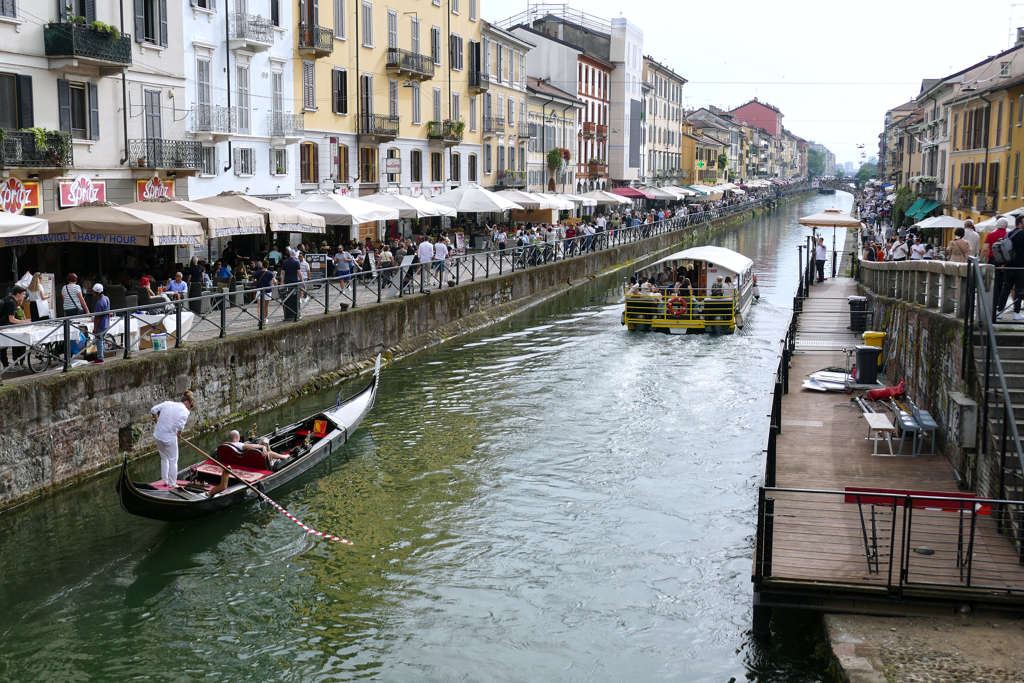
The decline of the Milanese canals began in the so-called Gründerzeit era. The cathedral harbor had already been filled in in 1857. By 1969, the bed of the ring canal was finally largely filled with cement. This was not a very popular decision. Due to strong protests, at least some sections of the Naviglio Grande and Naviglio Pavese as well as the Darsena harbor basin were preserved. Today, they are one of the most popular and lively nightlife areas in the city. So if you don’t have any other plans, you can always find an Aperitivo in good company alongside the Navigli.
Practical Information
How to Get There
By Plane
Milan has three airports: Malpensa, Linate, and Bergamo.
Linate mainly serves national and European travel and Bergamo caters mainly to low-cost airlines.
Malpensa, however, is the country’s second-largest airport after Rome-Fiumicino.
Two train lines connect Terminal 1 with the center of Milan. The Malpensa Express runs every 20 – 40 minutes. It stops at Milano Centrale, Cadorna and Porta Garibaldi stations. The journey, which takes around 50 minutes, costs 13 €uro and trains run approximately every 15 minutes.
The ride with the Terravision shuttle buses costs only 10 €uro and, with normal traffic, takes just as long as the train journey. If you buy a round trip, you only pay a total of 16 €uro!
Bus service is also offered from and to Linate as well as Bergamo.
It’s also possible to go straight from Malpensa to Linate – or vice versa. This is a great option in case you have a tight connection and cannot visit the city.
By Train
I know that Italian trains do not have a great reputation. I cannot subscribe to that. Having taken tons of trains in Italy, I never ever had to face major disruptions or problems.
Compared to other European countries, train travel is very cheap – if you book well ahead, even in first-class coaches.
Also, trenitalia, the national train company, has a very clear, well-functioning website. Here you can make a reservation and, hence, take advantage of great offers.
However, there’s one thing you have to be aware of when travelling to or from Milan. They have loads of train stations, whereby the most important are Milano Centrale and Cadorna. So when buying a ticket, always make sure to check the specific station in Milan.
The Times They Are A-Changin’
Do you remember those days when you had to validate your ticket before boarding the train? I’ll never forget a trip from Venice to Florence when I realized about 90 seconds before departure that I hadn’t validated my ticket. Now I had the choice between racing to the machine on the platform and risking the train leaving without me. Or staying on the train with an invalidated ticket and risking the controller fine me.
What did I do? Well, with my heart pounding like crazy, I ran to the machine, had almost a heart attack when the train made this exhaling sound as if it was about to leave, yelled noooo, stamped the ticket, ran back, hopped on the train – off we went.
Well, good news: Those days are gone – at least when you buy your ticket online which I highly recommend. Not only can you check in, e.g. validate your ticket, comfortably on your phone. You can also alter your booking before you check in!
That’s such a great service: You go online, choose your connection, and pay. Then you’ll get an email reminding you that your ticket isn’t valid until you check in online. This is a very easy process including two clicks.
However, you shouldn’t do it too early because until you’re checked in, you can change your ticket free of charge. Been there, done that, worked like a charm.
Therefore, I’d recommend checking in only as you get to the train station.
Long-Distance Bus
Travelling by bus is getting really popular in Europe. Although it’s a bit slower than taking a train, it’s often even more reliable and certainly much cheaper.
Most long-distance buses leave and arrive at the terminal Lampugnano. Nevertheless, there are also the terminals Famagosta and San Donato. Hence, here, too, check the exact destination.
How to Get Around
Obviously, there is a comprehensive system of public transportation in Milan. There are buses, trams, and even a subway. And still, there are so many places really badly connected and far from the stops. Therefore, you still have to do a lot of walking.
I personally don’t mind walking. For people who aren’t that fit or a bit gimpy, however, this might be a small issue.
A single ticket costs 2.20 €uros and is valid for 90 minutes after stamping. During these 90 minutes, you can travel as much and as often as you like. Hence, if you’re fast, you can use your single ticket even for a round trip.
Gone are the days when you had to get your ticket at a Tabacchi, hence a kiosk. Nowadays, you can just tap your NFC-equipped credit card, and you’re good to go – literally.
You can save a little money by buying a so-called Carnet of 10 Standard tickets for 19,50 €uros.
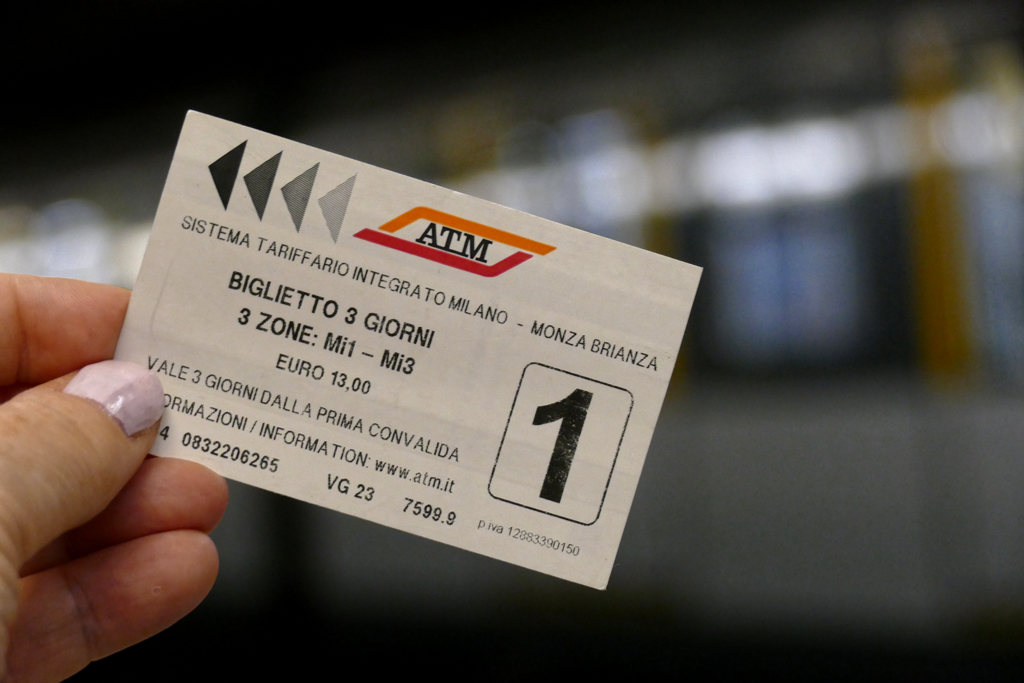
I’d argue the best deal is the so-called Milano Card. You cannot buy it from the driver, but need to get it at a ticket machine or a vendor like a Tabacchi. It comes in basically two versions: A 24-hour ticket for 7.60 €uros and a 72-hour ticket for 13 €uros. These two passes include an unlimited number of rides in zones Mi1 to Mi3. There are passes for other zones available, but I don’t think many visitors will actually need them.
Visiting Organized
Although I’m an avid solo-travelling woman, I sometimes like to join organized tours. This way, I get extended info about a place and it’s fun to visit landmarks in the company of like-minded fellow travellers.
Especially in summer, Milan can get really busy and tickets to the most popular attractions tend to sell out well ahead. Therefore, booking tickets’n’tour in advance is definitely recommended*:
Where to Stay
Milan is a big city and landmarks and places of interest can be found practically everywhere in the city. My favorite neighborhood is around Porta Venezia south of Milano Centrale, but that’s a very personal choice. Basically, every neighborhood has some lovely and alluring corners.
Therefore, here is a big choice of places in every neighborhood and for all budgets*:
Booking.comWhere to Eat
Where to Eat? Everywhere – it’s Italy, after all.
Besides the many restaurants, I particularly love to feast on Aperitivi. Aperitivo is a fantastic Italian invention. In the early evening before dinnertime, you go for a drink and feast on some complimentary niblets. What exactly you get depends on the business.

There are places that charge something like five €uros for an Aperol Spritz or any other long drink. You get some peanuts, crisps, or small chunks of focaccia and pizza with your drink.
In other places, you pay seven or eight €uros. But here the niblets are actually an entire dinner with small sandwiches, salads, pasta, you name it. I even had some curry at my favorite Aperitivo place! Most of the time, if you choose so, an Aperitivo can even replace an entire dinner.
The Exquisite Side of Fastfood
Unfortunately, it shows that I’m a sucker for carbohydrates. Therefore, Italy to me is heaven! Not only for the pasta. Mainly for all those snacks to go: Pizza, Focaccia, Pannini – dough everywhere.
As a solo-traveller, I’m not that keen on sitting down for a big lunch. Grabbing a snack to go is just fine. And in Milan, those snacks are offered basically at every corner.
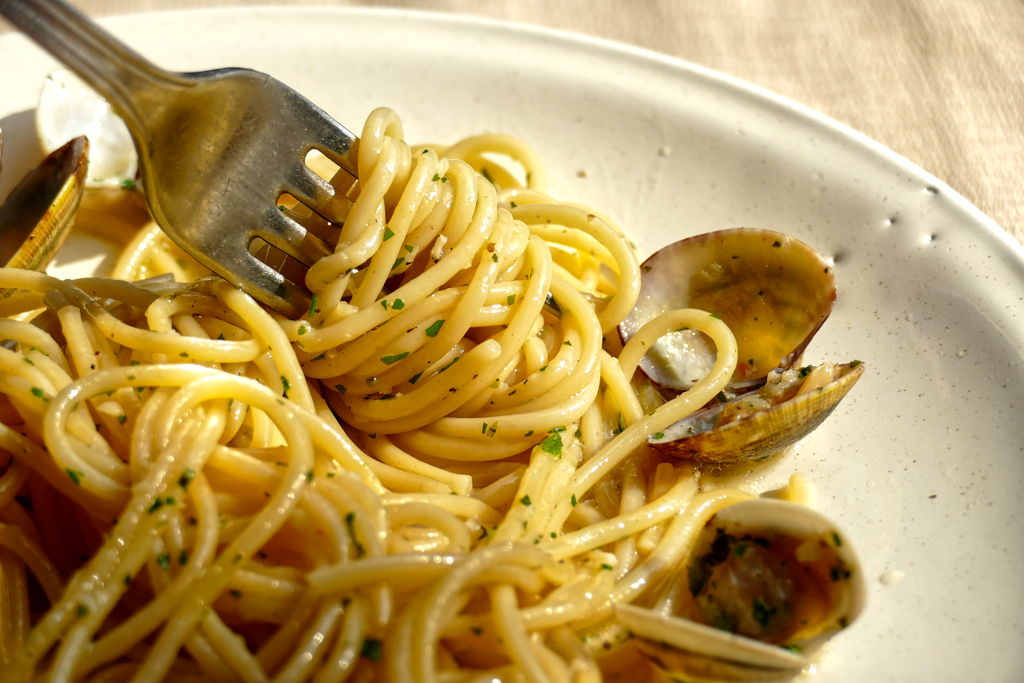
Another thing I love in Italy is the convenience food you get at supermarkets and smaller delis. There are various kinds of pasta, arancini, gnocchi, there are pot roast, and grilled chicken, accompanied by salad and roast potatoes. Everything is very tasty – and very Italian.
So if your accommodation has a microwave, buying food at supermarkets or delis is a great alternative. This way, you’ll get a full Italian meal and still save a lot of money.
My favorite deli in Milan is marked on the map above.
Cash, Cards, And Deals
Until now, 20 European countries have replaced their former local currency with the €uro starting in 2002. Obviously, Italy is one of them. The exchange rate is 1 US$ = 0.93 EUR as of July 2024. However, you can check today’s conversion rate on this page.

Mind you paying by card is accepted basically everywhere.
If it’s your first time in Milan and you want to see many of the classic landmarks, a tourist pass is certainly a good way to save a bit of money. There are very expensive passports where it can be almost stressful to get the equivalent value.
I would say the best deal for visitors is the MilanoCard. It grants unrestricted access to all public transport in the Milan metropolitan area. You’ll also receive free or discounted access to museums, tours, restaurants, and other tourist attractions. There are even some rather unusual perks like a 5 €uro credit for a taxi ride and a free drink at a bar. Depending on what works best for you, you can purchase the card with a validity of one to up to four days and, if necessary, add further options such as airport transfer or a visit to the Duomo. All variants are listed very clearly on their website.
Language
In Milan, many people speak decent English. However, older people don’t really like to speak it, even when they are working in the service and tourism sector. As a matter of fact, Italians can be deemed quite harsh and even unfriendly especially if you don’t speak the language. If you don’t want to spoil your vacation with other people’s rude attitudes, just ignore it. You won’t be able to change it, anyway.
Zushini, Gnotchi, Raditcho – I’m bleeding from my ears since I hear these mispronunciations so often.
Seriously, guys, it’s not so hard.
So here are some general rules: As in any other Romance language, C is hard when written before A, O, and U, hence, it’s pronounced K.
If followed by E or I, it’s tch as in witch.
Now, if a C followed by E or I should be pronounced K, an H is added: Bruschetta, Zucchini, Gnocchi, Radicchio – Brusketta, Zukini, Gnoki, Radikio.
On the other hand, if C followed by A, O, or U should be pronounced tch, they slip in a – silent! – I: Ciocolata, Ciabatta – Tchocolata, Tchabatta – forget about the I in-between.
Italian Classes in Italy’s Most Exciting Cities
As a matter of fact, it might be a great idea to learn some Italian or brush up on what you already know. A great place to do so is the Scuola Leonardo da Vinci. Not only do they have campuses in Milan and Rome, they are also in Siena and Florence.

If you are interested in taking Italian classes, but you’re insecure about how to organize your stay, don’t worry. The friendly and efficient ladies at the Scuola’s office are accommodating and can arrange literally everything for you – starting with an airport pick-up if you wish.
After a placement test, they advise you which class would be your best choice and help you with every little detail including providing housing for the duration of your course.
Connection and Communication
Since June 2017, no roaming charges have been applied within the EU with a European mobile phone contract, This applies in all 27 countries of the European Union as well as in Great Britain, Iceland, Liechtenstein, and Norway and to all contracts.
In case European roaming is unavailable, you can connect to the internet without any issue at basically every museum, eatery, café, and, of course, hotel.

If you insist on being online 24/7, you can get a SIM card, obviously. There are prepaid SIM cards by many companies.
TIM offers a prepaid sim card for tourists for 20 €uro with 40 GB data and they have a great 4G respectively 5G network in Italy. Of course does Traveltomtom also recommend e-sim cards for traveling to Italy. In fact, e-sim cards are the easiest way to stay connected as you arrange everything on the internet.
The standard voltage in Europe is 220 V and the frequency is 50 Hz. In Italy, they use three plug types, namely C, F, and L.
Whereby, since nowadays, all these chargers have integrated adapters, in general, the voltage and frequency don’t really matter.
You’ll find comprehensive travel info in my post World’s Most Complete Travel Information – an indispensable globetrotter-classic.
Map
On this map, you’ll find all the wonderful places I’m introducing in this post.
Clicking on the slider symbol at the top left or the full-screen icon at the top right will display the whole map including the legend.
Pinnable Pictures
If you choose to pin this post for later, please use one of these pictures:
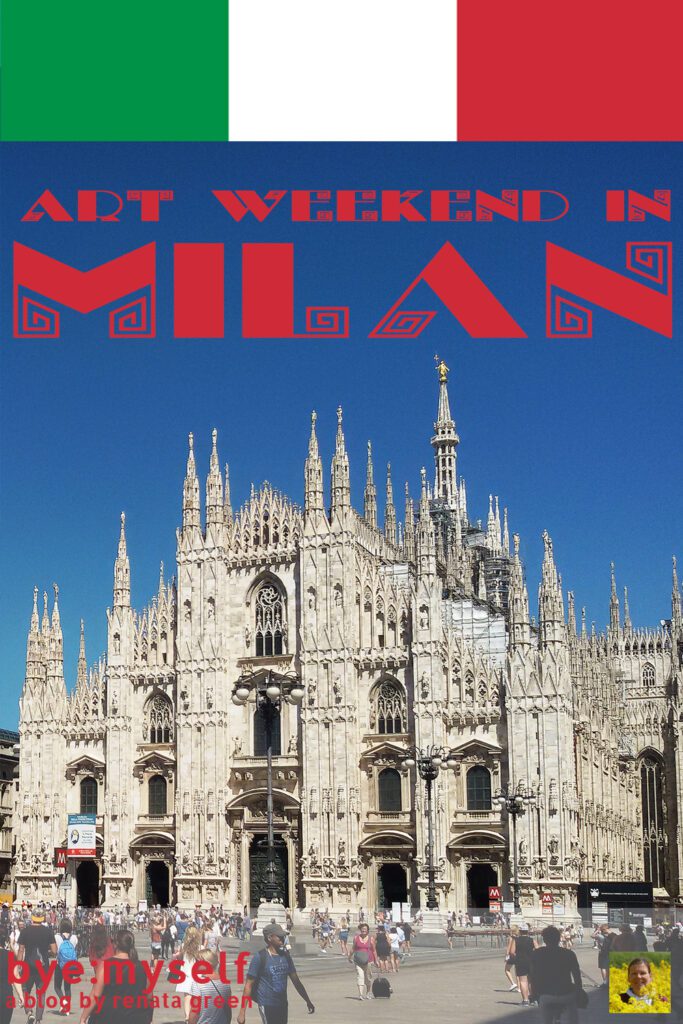





Note: This post is being regularly completed, edited, and updated – last in July 2024.
Did You Enjoy This Post? Then You Might Like Also These:
TORCELLO – a church, a bridge, and 15 residents
MURANO – BURANO – TORCELLO: A Self-Guided Island Tour
Complete Guide to COMO – a Lake to Like
VENICE on a Budget: When to Go, Where to Stay, What to Eat, And Much More
Day Trip to the LIDO di VENEZIA. Breaking Away from Venice
ROME for first-timers, repeat visitors, and eternal admirers
CAMOGLI – The Most Colorful Beach Town East Of Genoa
Welcome, World! Come In And Join Me In My Italian Online Course at the Scuola Leonardo da Vinci
*This is an affiliate link. If you book through this page, not only do you get the best deal. I also get a small commission that helps me run this blog. Thank you so much for supporting me!



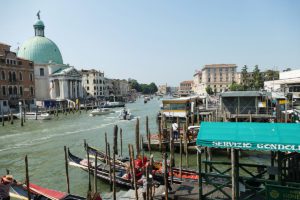




Great article! We are linking to this great article on our website. Keep up the great writing.
Thank you, I appreciate that 🙂
I could not refrain from commenting. Perfectly written.
Thank you so much for your short yet lovely comment!
Thank you for your input. There actually will be an update of this post this summer – hence, stay tuned!
Howdy! I just want to give you a huge thumbs up for your excellent information you’ve got here on this post.
Glad you like it! And good news: I’ll travel to Milan soon and will be able to put even more and super-fresh info in this post – so make sure to come back for it 🙂
I wanted to thank you for this fantastic read. I definitely loved every little bit of it. I have you bookmarked to check out further guides – especially those for city breaks.
I’m not that much of an online reader, to be
honest, but your site is really nice, keep it up! I’ll go ahead and bookmark your website
to come back in the future. All the best
Thank you. I try to keep up the quality of printed travel guides although I’m publishing online. Glad you appreciate it 🙂
Hi there! This is my first visit to your blog! We are a team of volunteers and starting a new initiative in a community in the same niche.
Your blog provided us beneficial information to work on. You have done
a wonderful job!
The iconic cathedral in Piazza del Duomo looks so beautiful. I would love to see that in person on day.
I feel this is among the such a lot vital information for me.
And i’m happy reading your article. However wanna
commentary on few general issues, The website taste is wonderful, the
articles is in reality nice : D. Good task, cheers
I haven’t been to Milan since I was a child, and I didn’t really appreciate it them. I visit Italy every year normally, so will make sure I visit Milan again soon. Your post will be most helpful as I love visiting art galleries and museums.
I think this website has got very wonderful written content articles.
Thanks on your marvelous posting! I quite enjoyed reading it, you may be
a great author. I will be sure to bookmark
your blog and will come back very soon. I want to encourage you to continue
your great writing, have a nice afternoon!
Thank you for sharing your thoughts. I really
appreciate your efforts and I am waiting for your next post thanks once again.
If you wish to increase your knowledge just keep visiting
this web site and be updated with the latest news posted here.
Fabulous, what a blog it is! This blog gives helpful
facts to us, keep it up.
Hello there! I could have sworn I’ve been to this
blog before but after browsing through a few of the posts I realized it’s new to
me. Regardless, I’m definitely happy I discovered
it and I’ll be book-marking it and checking back frequently!
Excellent web site. Lots of helpful info here.
I am sending it to a few buddies ans additionally sharing
in delicious. And of course, thanks to your effort!
I love what you guys are up too. This sort of clever work and
coverage! Keep up the very good works guys I’ve included
you guys to my blogroll. I couldn’t resist commenting.
Very well written!
I visited several websites but the quality at this website is really excellent.
Greetings! I’ve been reading your website for a while now and finally got the bravery to go ahead and give you a shout out from Houston Tx!
Just wanted to say keep up the great job! I am sure this article has touched all the
internet visitors, its really really nice piece of writing on building up new website.
Wow! wonderful journey. Thank you for taking me to milan.
That picture of you “making a foul out of yourself” really convinced me to give the palazzo dell arte a try! I would love to ne part of a pièce like that!
As a sucker for carbohydrates myself you literally had my mouth watering. I’d be in foodie paradise here for sure.
Milan is on my bucket list!
What a beautiful place in Milan I love their artworks so incredible.
I would LOVE to visit Milan one day. It looks incredible!!
Louise x
Milan is truly a heaven for all the art lovers! There are just so many galleries and museums that you can visit. Thank you for this helpful guide!
Milan is such a vibrant, full of culture and history city. I love that I saw it through your eyes.
I hate modern art, but Milan seems to feature a lot of classics!
Milan is definitely an art lover’s dream! I’ve been to Florence and Rome, and had Venice on my bucket list. Now I’ll have to add Milan.
Milan is so beautiful! I’ve been to Italy several times but never Milan. Definitely on our bucket list. Thanks for sharing!
Milan has always been on my list of places I’d love to visit and now I’m even more intrigued. Great post!
The city looks so beautiful at night. And the food looks delicious!
hi
truly Milan is home to world cultural heritage, historically significant buildings, and art treasures. The same is evident from your post. I would have loved to visit the Galleria D’Arte Moderna and look at the centre masterpiece of the morning prayer while the artefact at the Padiglione d’Arte Contemporanea which you have clicked seems amazing
I absolutely loved the cemetery in Milan, I actually went on Christmas Day this last year, because it was about the only thing open. I can’t wait to go back and explore the rest of these galleries!
Milan is such a beautiful place I really want to visit someday, after this Covid19. Thanks for sharing this suggestions. Will definitely save this on my references.
Ahhh I just love Milan – can’t wait to get back after all this mess! 🙂
What’s up, I check your blog on a regular basis.
Your writing style is awesome, keep it up! I’ve been surfing online more
than three hours today, yet I never found any interesting article like
yours. It is pretty worth enough for me. In my opinion, if all webmasters and bloggers made good content as you did, the internet will be much more useful than ever before.
Waoo such beautiful art.. I would really love to visit Milan’s galleries ?
It was interesting seeing Milan through your eyes! Thanks for sharing!
This right here is why Milan is on my bucket list. Look at this place.
I didn’t get to visit Milan when I was in Italy. I’d love to go there one day to sightsee and shop!
These places look and sound amazing!
Great post. I didn’t realise Milan wasn’t full of attractions like other cities in Italy. But your post has sold me on what’s to offer. Like you say if you go in knowing how it is you have a better chance of enjoying it.